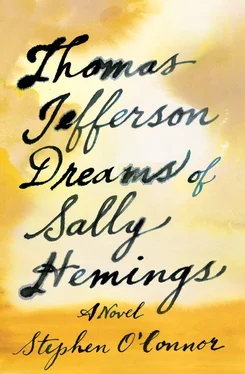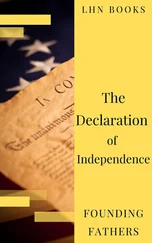Some of the displays are amusing — particularly the dioramas. One shows Thomas Jefferson standing in front of a fireplace playing a violin while mannequins representing his granddaughters, Ellen and Cornelia, both looking about eleven years old, whirl, elbows linked, in a merry jig. Almost everything is wrong with this exhibit. First of all, Cornelia absolutely hated dancing, in part because her actual proportions — unlike the mannequin’s — verged on the elephantine. Second of all, no one’s clothes make sense. Thomas Jefferson is wearing a braided, gold-buttoned, royal blue frock coat, which is far too formal for so humble and domestic an occasion. And his waistcoat is an absurd geranium red, such as a tavern keeper might wear. The girls, by contrast, are in mauves and pigeon gray, which they would have considered too dour and old-fashioned even for their grandmothers.
Most ludicrous of all are the faces of the mannequins, ostensibly based on portraits painted “from life.” Thomas Jefferson, at least, looks as if he belongs to his own family — though not any closer to himself than a second or third cousin, and the grin on his face is the sort that only accompanies intense discomfort of the lower intestine. The mannequins representing the girls both look like demented elves, neither bearing the faintest resemblance to the actual Ellen and Cornelia.
Sally Hemings is also in the scene, though her face is not visible, since she is shown watching the family merriment from a dark hallway.
In every single one of the dioramas and modern illustrations, Sally Hemings’s face is either in shadow or turned away from the viewer. This is because, as the captions to the displays repeat time and again, if any portraits of her were ever made, none has survived. She understands that the absence of her face represents the museum curator’s desire both for historical accuracy and to make a statement about her “invisibility” in Thomas Jefferson’s world, yet she can’t help but feel affronted that she alone, of all the people represented, is deprived of the most significant physical manifestation of identity, especially since the faces of every other member of the Jefferson family and social circle could hardly be less historically accurate.
She is also disturbed to see the knives, forks and spoons she remembers as shiny copper and silver looking black and withered, and the blue china plates off which she ate thousands of meals now only partially reconstructed assemblages of variously discolored fragments. Particularly disturbing is a display of miscellaneous bits of pottery unearthed at Monticello, in which she notices two arced pieces of the jam jar in which she buried La Petite. Thomas Jefferson passes right over this display without even noticing what it contains, and she doesn’t bother to inform him. She lingers behind as he moves on to other exhibits, however, and it is a long while before she can bring herself to stand near or talk to him again.
In the end she is moved to return to his side and, finally, to take hold of his hand by the responses of the other people in the gallery — about half of whom obviously have African ancestry. The overwhelming message of the show, rendered anew in exhibit after exhibit, is that when it came to the Africans with whom he spent almost every day of his life, Thomas Jefferson was a selfish and spitefully prejudiced hypocrite — which, indeed, he was, Sally Hemings realizes far more clearly now than she ever did at the time, though that is not all that he was. As he and she move between pools of illumination in the twilit rooms, people are constantly murmuring sourly to one another and making comments like, “What a bastard!” Or, “I used to admire this guy!”
Thomas Jefferson gets few second glances, however, and maybe one or two stares, but no one comes up to him, no one cups a hand over his or her mouth and whispers into a neighbor’s ear while glaring at him fiercely. But as he and Sally Hemings are watching a video in which some of his writings on slavery are read aloud by an actor, a man of African descent does look directly at Thomas Jefferson, and says in a loud voice, “This country would have been a hell of a lot better if all the white people had been sent to Ohio or Canada!”
Thomas Jefferson responds to this man’s words and, indeed, to every other overt or implicit disparagement he receives that day, as he always responds to criticism: by pretending not to notice it.
As he and Sally Hemings are leaving the video, she takes his hand in both of hers, moves her lips next to his ear. “I hope this is not more than you can bear,” she says.
At first he only sighs heavily without speaking. But after a long moment, he says, “It seems that I never…” He is silent another long moment, then shrugs and pats her hand. He doesn’t look her in the eye.
As they draw near the end — which is to say the beginning — of the show, they come to a vitrine displaying the very gown that Sally Hemings was wearing the day they went to see le Comte de Toytot fly in a hot-air balloon and that she was also wearing later that night, when Thomas Jefferson forced himself into her room.
They stand side by side in front of the vitrine, as if before an apparition, their faces tremulous with the repeated impacts of possibility and doubt. The gown, suspended in midair by nearly invisible fishing line, is the only item in the whole exhibit that seems untarnished by time, its yellow silk radiant in the spotlight and its white underskirts as brilliant and luxurious as clouds.
After a moment they notice a guard standing next to them. He is dark-skinned and heavyset, and he is smiling at Sally Hemings. “Would you like to try it on?” he says.
“Is that allowed?” she asks.
The guard nods beneficently. “For you, of course.”
He pulls out a set of keys, attached to his belt by a chain, unlocks the back of the vitrine and detaches the gown and its underskirts from the fishing line. As he hands them to Sally Hemings, he nods wordlessly toward the door of a women’s room.
She takes the gown and skirts into her arms as if they are the wasted body of a child. When she emerges from the women’s room, her expression is solemn and intent. She is barefoot, clutching her raincoat against her chest.
The guard has left the room, and for the first time since they entered the museum, Sally Hemings and Thomas Jefferson are entirely alone. “You have to do me up,” she tells him, and turns her back. “The stays are missing, and there is no hoop. I’m sure I’ll look terrible.”
“It will be fine,” says Thomas Jefferson as he fastens the many little buttons from just below her waist to the nape of her neck.
And, indeed, when she hands him her raincoat and turns to face him, she seems hardly to have changed since she last wore the gown so many years ago.
She is looking into his eyes, waiting, still solemn and intent. He is afraid to speak. He is feeling so many different kinds of sorrow, but also a lightening of spirit — something very like hope.
She swallows and parts her lips, as if to form a word. But then she clamps her mouth into a thin seam, and the skin around it goes yellow. She is still looking into his eyes, and he is looking into hers.
The guard has returned, stepping sideways through the door, glancing over his shoulder toward the room he has just left. Then he looks directly at Sally Hemings, tilting his head to one side, his brow furrowing and his lips going into the lumps and twists of someone who wants to smile. Finally he shrugs and parts his open hands in the gesture that signifies helplessness. There are murmurs in the next room, and the whisper of shoe soles on polished wood.
Col. Jones had by this time become very fond of me, and would not arrange any terms by which I could gain my freedom. He respected me, and would not let me see him take his “bitters.” He was surprised and pleased to find that I did not touch liquor. Being with and coming from such a family as Mr. Jefferson’s, I knew more than they did about many things. This also raised me in their esteem. My sister Isabel was also left a slave in Virginia. I wrote her a free pass, sent her to Boston, and made [an?] attempt to gain my own freedom. The first time [I fai?]led and had to return. My parents were here in Ohio and I wanted to be with them and be free, so I resolved to get free or die in the attempt. I started the second time, was caught, handcuffed, and taken back and carried to Richmond and put in jail. For the second time I was put up on the auction block and sold like a horse. But friends from among my master’s best friends bought me in and sent me to my father in Cincinnati, and I am here to-day.
Читать дальше












